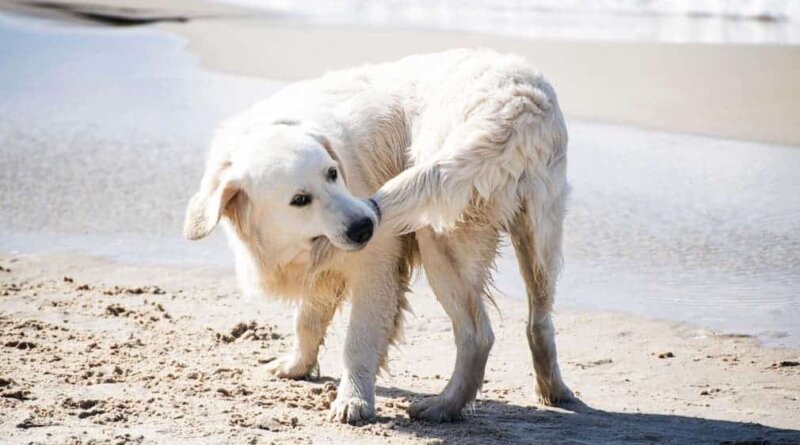Dog Chasing Tail Obsession | Cesar’s Way
Dear Cesar:
We have a ten-year-old lab/pit bull mix. He is housebroken and can do a few tricks. The only problem is he LOVES to chase his tail. Whenever someone comes into the house, or even if there is any loud noise, he chases and chases and chases until he catches his tail. He can walk down the hall with it in his mouth and climb into his chair.
He came from the shelter about eight years ago, and I thought this was a behavior he did there to keep himself occupied. Can you help?
Lois Harvey
Cesar Millan’s Answer:
Dear Lois,
For dogs, some habits can be harder to break than others. In my experience, a dog chasing its tail often signifies boredom. Sometimes, it can be a physical reaction to excitement. Based on your description, I’m leaning toward excitement. If this behavior is causing your dog physical health problems, then I suggest you remedy the problem by using a correction method that is both calm-assertive and humane. Remember, timing is everything, which means you have only a few seconds to correct the behavior as soon as it’s displayed. Otherwise, it may be too late for him to connect his actions with your corrections. Hopefully, with a little practice, he can learn to bite a chew toy as a substitute behavior for possibly harming himself by biting his tail.
Stay calm and assertive,
Cesar Millan
What is Tail Chasing Behavior Trying to Communicate?
Why do dogs chase their tails? This habit can indicate various issues your furry friend may be going through. It could mean boredom, pain, or even anxiety. Moreover, it could also signify obsessive-compulsive behaviors, mainly if performed repeatedly and persistently.
If you see your pet chasing his tail habitually, finding the underlying cause and addressing it appropriately is essential. Consulting with a veterinarian can help you ensure that no medical conditions are causing this behavior. It is also vital to provide your furry friend with plenty of outlets for their physical and mental stimulation so they can enjoy life without any behavioral challenges.
Why Do Dogs Chase Their Tails?
Dogs bite and chase their tails for various reasons, ranging from playful exploration to signs of compulsive behavior. Compulsive behaviors are characterized by their tendency to become more frequent and intense over time, potentially requiring medical or behavioral treatments to mitigate them. If your dog has developed a tail-chasing habit that appears to be compulsive, it is recommended that you speak with your veterinarian.
Excessive Energy
When your dog chases their tail, it is often a sign of a lack of mental stimulation, wanting attention, or needing to burn extra energy. This is particularly true for puppies and younger dogs who enjoy the thrill of running in circles.
Boredom
Dogs require active physical and mental stimulation to maintain a healthy state; if they become bored, they may exhibit destructive behavior such as chewing on their tail.
Fleas
Fleas are tiny insects that can attach to dogs, causing discomfort and potentially leading to tail chewing as a symptom.
Medical Condition
Dogs sometimes chase and bite their tail if they’re feeling itchy or uncomfortable from an allergy, or it could be a sign that something’s not right internally, such as a tail or spine injury.
Parasites
Dogs with worm infections may exhibit behavior such as chewing their tail to alleviate irritation. If your dog is trying to chew on their tail, it may initially try chasing it. However, they are more likely to sit and contort their bodies to reach the itchy spot. To ensure that nothing serious is causing the itching sensation, check for any signs of parasites and contact a vet for an expert opinion.
Anxiety
Nervousness can lead to a dog licking or chewing its tail, particularly in the presence of unfamiliar visitors or during storms.
How to Stop Your Dog From Chasing Their Tail
While occasional tail chasing is okay, if your pup seems to chase his tail obsessively, he may be telling you he needs more positive reinforcement and a less stressful environment.
Positive Reinforcement Techniques for Helping Dogs Stop Chasing Their Tails
Positive reinforcement is an effective and humane way to train and modify dog behaviors. This type of training uses rewards, such as treats, praise, or simply a pat on the head, to reinforce desired behaviors. Its focus is strengthening behavior that is already occurring rather than punishing negative behaviors (which could be counterproductive). When used correctly, positive reinforcement can effectively teach a wide range of commands and behaviors. It can also help engage dogs with their owners, allowing them to create strong and lasting bonds based on mutual trust and respect.
Easy Tips for Positive Reinforcement Training
- Keep training sessions short and fun.
- Give praise and reward immediately.
- Be consistent in your expectations.
- Slowly wean from giving treats.
Reducing Stress and Anxiety Levels
Consider any potential triggers if your dog’s tail chasing could be due to stress. This can include changes in their home, the presence of other dogs, or something else that might be causing them concern. To help relax your dog, provide them with a space where they can observe their surroundings. Petting them is another way to make them feel more comfortable and could help stop tail-chasing behaviors. Consider what you can do to create a relaxed atmosphere for your furry friend.
Ways to Create a Relaxing Environment
- Easy-to-access water and food.
- Provide mental stimulation through games.
- Provide plenty of daily exercise with walks, playtime, and other activities.
- A fixed place for their downtime and rest.
Safe Chewing Objects for Your Dog (Instead of Their Tail)
Providing dogs with appropriate chew toys is an important behavior management tool for preventing tail chasing. Chew toys are essential for mental stimulation and distraction, keeping your dog’s focus away from their tails. When selecting toys, remember that the object should always be appropriate for your dog’s size, age, and energy level, providing something stimulating to focus their energy on instead of chasing their tails.
Avoid toys that look like everyday objects to prevent confusion; for example, do not provide a chewable old shoe, as this could be mistaken for a new pair.

When to Consult a Veterinarian or Behavior Specialist
It’s not uncommon to see a dog chasing his tail, but that doesn’t mean it’s normal. If your pup is exhibiting this behavior often and continuously, it’s time to contact a professional. Dog experts will explain why dogs chase their tails and recommend treatments for the underlying cause. For instance, behavioral specialists can identify if your pup is chasing its tail due to boredom or an obsessive-compulsive disorder. A vet can determine if there’s a medical reason behind the behavior and rule out any possible pain or discomfort caused by an injury or parasite infection.
Pinpointing the exact cause of tail chasing will help create an effective solution and promote a higher quality of life for you and your pup.



